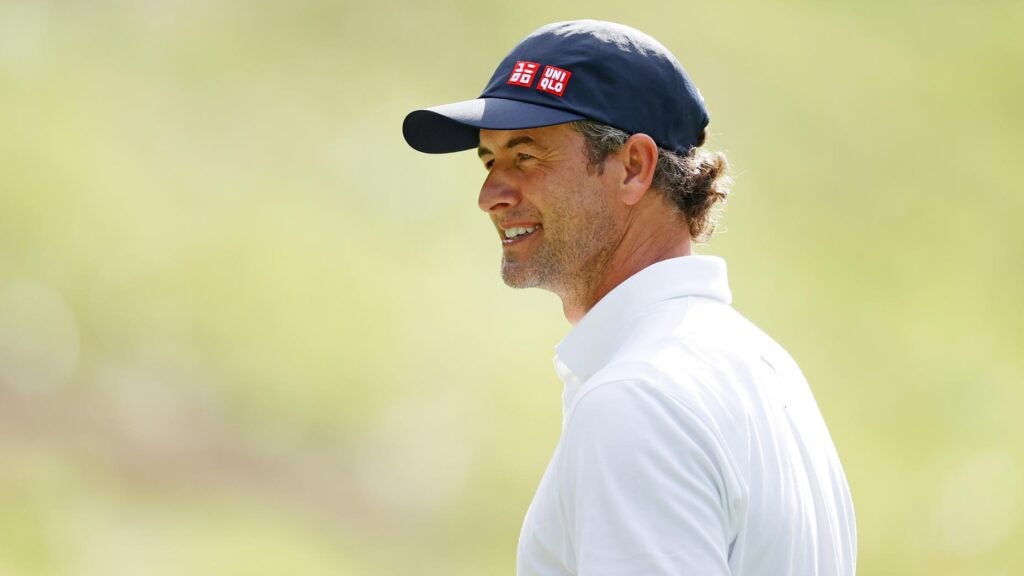After the Masters this past November, Adam Scott came up with a plan for what he needed to do to attack the 2021 golf season head-on. That plan?
“Play better,” he said.
Easier said than done, right? Not really, says Scott.
“I think at this point in my career, with the years of experience and the knowledge of my own game, I mean, it shouldn’t be too difficult.”
Scott gets plenty of attention for his green jacket, his glorious golf swing and his arresting good looks. But he doesn’t get quite enough credit for becoming one of the Tour’s most plain-spoken players. As his career winds on, Scott has grown increasingly comfortable answering questions thoughtfully and honestly. That might not sound like a revolutionary concept, but in some corners of sports — the golf world especially — players treat honesty as proximal to danger. Not so much the 40-year-old Aussie.
On Thursday, as PGA Tour golf resumed at the Sentry Tournament of Champions, Scott opened with five-under 68. He was delighted with how he hit the ball, describing it as his best ball-striking round “in about four years.” That was interesting in itself; most pros like to downplay even their best rounds as status quo. But Scott’s insights on the Tour schedule in general were far more revealing.
A question about this week’s expanded field led to talk of the Tour Championship. What does he make of the recent format changes, which mean the player who shoots the lowest score might not win?
“I think as a whole, as the Tour, we have decided that that event is not a normal event,” Scott said. “The Tour Championship is now the finale of the FedEx Cup and it doesn’t run like a usual tournament. Yes, it’s peculiar, but other tournaments have changed their formats as well, like [team event] New Orleans did, and the Stableford [in Reno] as well.”
As a golf fan, it can be difficult to keep track of which tournaments matter the most. The major championships are clearly front and center in the public consciousness, but then there are the WGCs and the Invitationals and the FedEx Cup Playoffs — and then there are the rest of the tournaments, too, four dozen of ’em crammed into each calendar year. Each Tour event is beautiful in its own way, of course. But how do we make sense of their hierarchy?
“I think somewhat that there’s not space for 50 stroke-play events in the calendar year,” he said. “I mean, they can’t all be serious, 72-hole events. Some of this is, of course, about competition, but it’s also about entertainment, when there’s so much of it, and the Tour’s got to try and find that balance.”
Scott was cognizant of golf’s big-time numbers in 2020, “ratings-wise and participation-wise,” but he’s among those pros who sees room for other formats in the professional game. He’s open to the idea of more match play and even embraced the idea of a mixed team event featuring PGA Tour and LPGA Tour pros in the same field.
“Well, yeah, I mean there’s so many events it doesn’t matter,” he said. “Absolutely.”‘
Then he put his thesis all together:
“Like I said, I think you’ve got to identify that there’s probably 10 or 12 serious competition events during the calendar year and then the rest is a bit of entertainment, really, but the thing for all of us and people trying to peak for those 10 or 12 serious events is they have got to use those entertainment events to get prepared and get ready. So it’s finding that balance of your schedule and also for the Tour’s schedule and what’s entertaining and how seriously it should be taken.”
This is, of course, the mindset only of the Tour’s upper crust. Thousands of aspiring pros would kill just for a chance to compete in one of these low-key Tour events, and plenty of pros with their Tour cards grind week-in, week-out just to try to hang on to their spot in the sport’s top tier. Joel Dahmen aptly described this as the difference between the “PGA Tour” and the “PGB Tour.” There’s no doubt that it’s good to have status on the latter and far better to join the ranks of the former. That’s when some events can become more special than others.
Midway through the broadcast, Golf Channel flashed a familiar graphic entitled “Golf’s biggest events.” That no longer just means the majors — this graphic added the Players, the Olympics, the FedEx Cup Playoffs and the Ryder Cup. That’s 10 tournaments in all and that’s before you include big events like the invitationals at Riviera, Bay Hill or Muirfield Village, not to mention the four WGCs. It’s understandably confusing, and Scott’s openness yields a little more insight into how players themselves see things.
Just don’t take it as apathy: The 40-year-old Scott is awfully interested in winning a bunch more tournaments, and fast.
“I would like to quickly get to 20 PGA Tour wins at this point,” he said. “I think that would be a nice little accomplishment for me and obviously winning another major and trying to do a Brooks or a Jordan or a Rory and win a few really quick. Because quick is important at this point.”
Five under is a good start. He’ll continue that pursuit over the weekend in Hawaii, whether it’s entertainment, serious competition or something in between.
